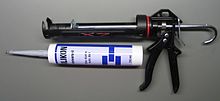Cartridge gun
A cartridge gun (also known as a cartridge gun or a skeleton gun ) is a tool with which, for example, silicone cartridges or so-called foil bags, also known as "economy packs", can be squeezed out. The media to be processed are usually sealants, such as silicone or acrylic , or adhesives. Composite mortar (injection mortar) can also be injected into drill holes with such cartridges, but usually has a higher viscosity . Highly viscous contents usually require much more stable cartridge guns.
Cartridge guns are divided into different categories of design:
- Skeleton pistols that consist of a thin frame made of plastic or metal and can represent the cheapest option.
- Cartridge guns with and without toothed rack designed as half-shells .
- Cartridge guns with barrel : These guns have a screw cap and the cartridges are inserted from the front. High-quality models allow the processing of cartridges and foil bags by converting the pressure stamp.
Cartridge guns are further subdivided into different categories of the origin of the force exerted to squeeze out the sealing compound or the adhesive:
- Hand pressure pistols : with a power transmission ratio of 7: 1 (simple skeleton pistol), 10: 1, 12: 1, 18: 1 or 25: 1 This means that with 10 N pressure on the handle, depending on the model, between 70 and 250 N pressure on the cartridge can be exercised. Most DIY stores only offer models with 7: 1 and 10: 1 compression ratio. Higher transmission ratios require a correspondingly more stable structure of the pistol and are therefore only available in higher-quality models.
- Compressed air pistols: Here there are only pistols with a tube, whereby either compressed air acts directly on the bottom of the cartridge from behind or the air indirectly presses a telescopic piston or a push rod with a pressure plate onto the bottom of the cartridge.
- Battery pistols : are available in variants with a half-shell or with a tube. Such battery guns with battery voltages of 2.4V to 18V are common, with devices for commercial use being able to generate pressures of up to 5000N. This can bring inferior cartridges to their limits.
function
The cartridge is inserted into the gun from above. By operating the hand lever, a rod is pressed against the bottom of the cartridge from behind. As a result, the bottom moves into the interior of the cartridge and presses the material in the cartridge out of the nozzle at the front. A retaining clip usually prevents the rod from sliding back, but it can be loosened to remove an empty cartridge.
Areas of application
The cartridge gun is mainly used in construction to press silicone, adhesives or other jointing material into appropriate joints or cavities. Composite mortar (injection mortar) is used to fasten heavy-duty anchors. This usually consists of two components, which are only mixed in the special nozzle (static mixer) when squeezing out and therefore special cartridge guns are sometimes necessary.


